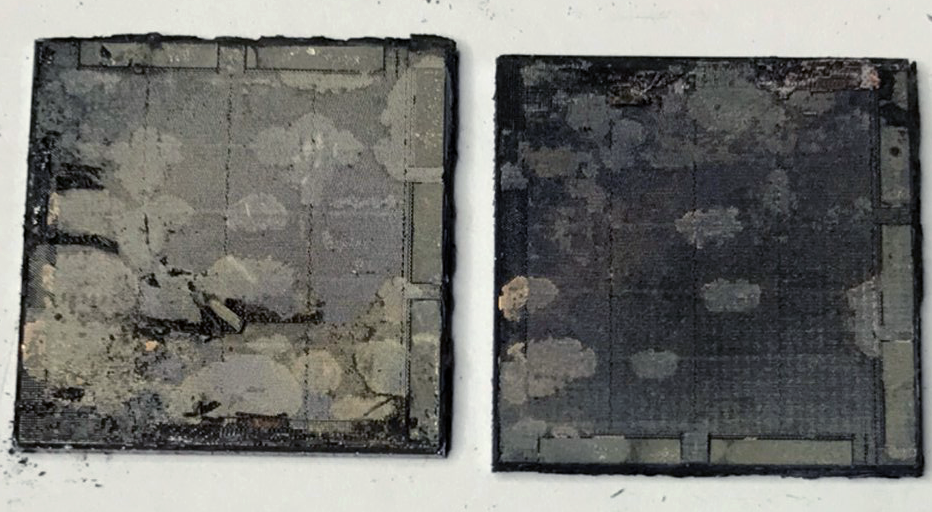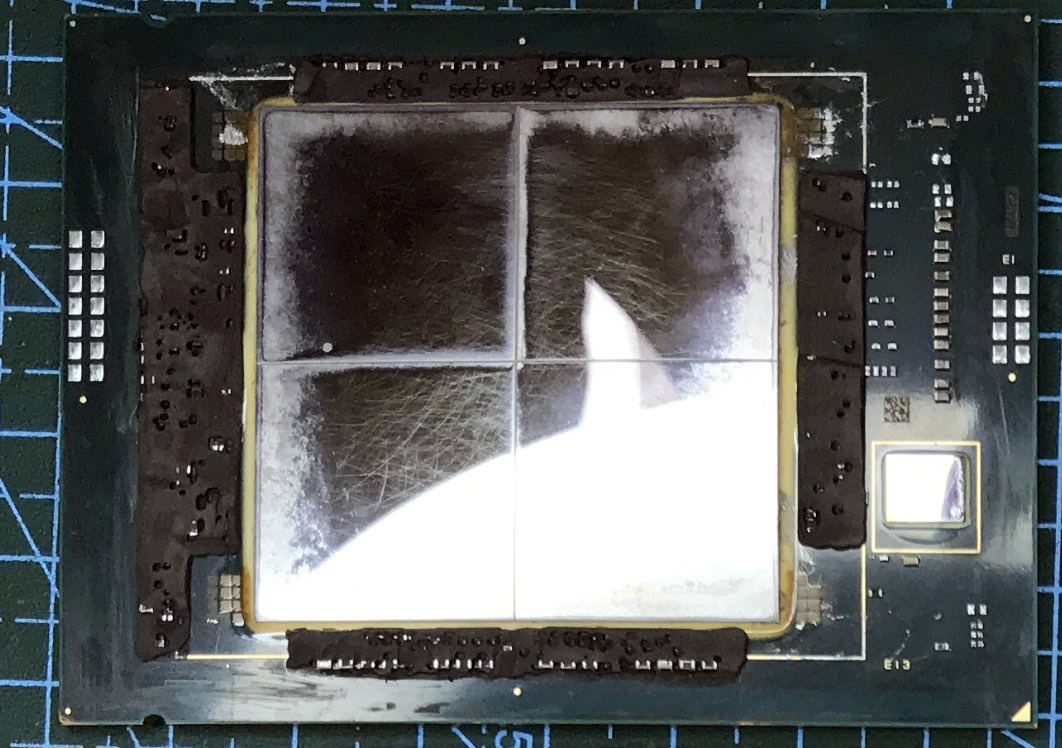Intel's Sapphire Rapids Could Have 72-80 Cores, According to New Die Shots
Making waves
Newly published images may reveal that Intel's forthcoming Sapphire Rapids CPU might feature roughly 72-80 cores, considerably more cores than initially thought.
Hardware blogger YuuKi_AnS, known for various leaks, has published pictures of what is claimed to be Intel's Sapphire Rapid chiplets. This time around he removed the dies from the substrate and exposed their flip side. To great surprise, this reveals a 4×5 group of similar elements which are believed to be Sapphire Rapids' CPU cores. With each chiplet carrying 20 dies (or die candidates, specifically), higher-end Sapphire Rapids processors could have as many as 80 cores, whereas lower-end chips would of course feature fewer cores.
Previously it was reported that Intel's Sapphire Rapids will come with up to 56 Golden Cove cores, based on a slide that presumably came from Intel. That 56-core Sapphire Rapids CPU was claimed to have a TDP of 350W.
The disassembled Intel Sapphire Rapids sample is exactly the same CPU that was first pictured in February, more than three months ago, so it is not a new sample or an old sample, but the very sample that was obtained from an Intel partner either early in 2021 or late in 2020.
According to market rumors, Intel supplied its Sapphire Rapids samples with 28 enabled cores, and many believed that the company activated only half of the cores that its chiplet physically had (i.e., 7 out of 14). As it transpires, Intel's Sapphire Rapids features 20 cores per chiplet, which theoretically allows Intel to build SPR processors with up to 80 cores. Meanwhile, 56-core CPUs will have six redundant cores per chiplet, which is way too many. By contrast, two redundant cores per chiplet would enable 72-core CPUs.
Keep in mind that Intel has never confirmed the number of cores it plans for its Sapphire Rapids processors, and plans could always change. So take all this server silicon speculation with a few multi-core grains of salt.
Get Tom's Hardware's best news and in-depth reviews, straight to your inbox.

Anton Shilov is a contributing writer at Tom’s Hardware. Over the past couple of decades, he has covered everything from CPUs and GPUs to supercomputers and from modern process technologies and latest fab tools to high-tech industry trends.
-
TheJoker2020 If 56 of its potential 80-cores were enabled at 350-Watts of power used, that is 6.25W per core, at the same clock speeds an 80-core chip would eat an astonishing 500W :eek: Toasty...Reply
Perhaps Intel and partners decided against this, or perhaps within the 350W limit with more enabled cores they had to drop the frequency so low that it didnt perform well.
Most likely though is that they had serious issues with the yeilds AND these suck stupid amounts of power, that is a devestating combination of failure.
Perhaps intel could fix this if they even manage to get larger dies produced on their 10mn process, or perhaps better still, get Samsung or TSMC to produce these chips :devilish: -
thGe17 ... or 350 W is simply the upper regular limit for the new socket und the 56-core-version uses a higher clock instead? ;)Reply
Serious yield issues? Most likely not, because this is only a 20 core design, therefore it is relatively small. Ice Lake SP as a XCC ist currently a monolithic 40 core design, this is something completely different. -
spongiemaster Reply
That's not how the math works. Obviously as core count increases, clocks decrease to keep power in check.TheJoker2020 said:If 56 of its potential 80-cores were enabled at 350-Watts of power used, that is 6.25W per core, at the same clock speeds an 80-core chip would eat an astonishing 500W :eek: Toasty...
AMD Epyc 75F3 is a 32 core CPU with a 280W TDP. 8.75W per core. That's 700W for an 80 core chip. :eek: Mega Toasty!!! What on earth is AMD doing? Devastating failure. -
TheJoker2020 Reply
Unless Intel decided to just let it rip and increase the power limit to 500W to keep the performance per core the same (notwithstanding the cooling requirements).spongiemaster said:That's not how the math works. Obviously as core count increases, clocks decrease to keep power in check.
spongiemaster said:AMD Epyc 75F3 is a 32 core CPU with a 280W TDP. 8.75W per core. That's 700W for an 80 core chip. :eek: Mega Toasty!!! What on earth is AMD doing? Devastating failure.
We both know that the 75F3 is the balls out 32 core version that will have few sales compared to others in the line as few will actually want these types of CPU's compared to the normal line of EPYC CPU's, which were designed and BUILT with 64-cores, unlike these Intel CPU's that seemingly have a heap of cores disabled and I postulated that heat and yeild are almost certainly large factors.!
Intel on the other hand are doing exactly what AMD was FORCED to do with Bulldozer and pump up the power to just try and compete with the standard EPYC CPU's, oh how things have changed. -
JayNor the fuse.wikichip ice lake server launch article had a mesh layout diagram that showed pcie, dmi, memory controller and upi blocks as equal sized squares on the mesh grid.Reply
It isn't clear to me if this was meant to imply that the physical sizes of those non-core blocks were equal to the size of the cores, or if it was just a logical diagram.
Any insight on if the 4x5 blocks on this leaked SPR photo are all cores, or if they could be non-core functions? -
JayNor semianalysis has a more thorough analysis of the Ice Lake Server 40 core die, which indicates it has 42 cores.Reply -
Awev To me it looks as if Until is trying to do less with more - more cores, more of a price tag, more power, less performance.Reply -
JayNor ReplyAwev said:To me it looks as if Until is trying to do less with more - more cores, more of a price tag, more power, less performance.
moving from Ice Lake Server to SPR transitions pcie4 to pcie5/cxl, ddr4 to ddr5, ai vector processing to ai matrix processing, from 40 cores to 56 (or 72 or 80) cores, from Optane v2 to Optane v3, from Sunny Cove to Golden Cove cores ... all acknowledged performance increases, but, yes, expected to raise power ...
Their processing moves from 10nm to 10esf on SPR.
Looks like Intel's big assault on power comes with 7nm EUV in 2023.
They have notably demoed 224Gb PAM4 transceivers and an optical switch with co-packaged optics. -
spongiemaster ReplyTheJoker2020 said:Unless Intel decided to just let it rip and increase the power limit to 500W to keep the performance per core the same (notwithstanding the cooling requirements).
Don't act stupid just to argue. Intel's current 10nm Ice Lake SP CPU's top out at 270W TDP. Sapphire Rapids is not going to top out at 500W TDP. So just drop that now.
We both know that the 75F3 is the balls out 32 core version that will have few sales compared to others in the line as few will actually want these types of CPU's compared to the normal line of EPYC CPU's, which were designed and BUILT with 64-cores, unlike these Intel CPU's that seemingly have a heap of cores disabled and I postulated that heat and yeild are almost certainly large factors.!
I used the exact same logic you did. The only difference is you're basing your calculations on an early engineering sample from Intel which makes it even more worthless. -
TheJoker2020 Reply
You could at least try to be polite, this is all speculation at this point.spongiemaster said:Don't act stupid just to argue. Intel's current 10nm Ice Lake SP CPU's top out at 270W TDP. Sapphire Rapids is not going to top out at 500W TDP. So just drop that now.
spongiemaster said:I used the exact same logic you did. The only difference is you're basing your calculations on an early engineering sample from Intel which makes it even more worthless.
Deliberately only replying to "part" of my quote (thus misquoting me) is exactly what the press and politicians love to do, two of the most untrusted proffessions on Earth, don't be like them, be civil, be polite and we can happily speculate and discuss without getting into the gutter.!

